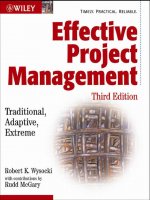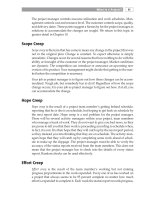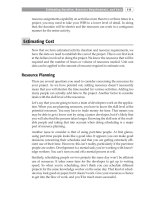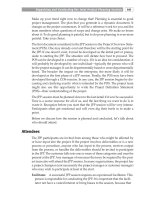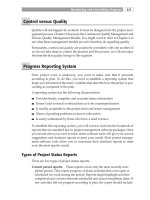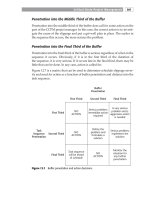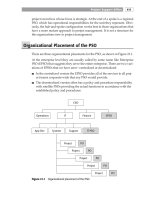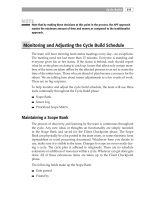145 test bank for effective project management traditional adaptive extreme 4th edition wysocki
Bạn đang xem bản rút gọn của tài liệu. Xem và tải ngay bản đầy đủ của tài liệu tại đây (212.19 KB, 45 trang )
Test Bank for Effective Project Management
Traditional Adaptive Extreme 4th Edition Wysocki
True - False Questions - Page 1
“Define the project” is the first phase of Traditional Project Management.
1.
True
2.
False
The Work Breakdown Structure is another name for the Project Network.
1.
True
2.
False
A detailed description of each work activity is part of the Project Proposal.
1.
True
2.
False
The problem or opportunity is discussed in the Defining Phase of
Traditional Project Management.
1.
True
2.
False
Planning has no effect on risk.
1.
True
2.
False
The project team is recruited and organized during the Launching Phase
of Traditional Project Management.
1.
True
2.
False
During the Planning Phase of Traditional Project Management, the project
activities are identified.
1.
True
2.
False
The assumptions and risks are listed before the Defining Phase of
Traditional Project Management.
1.
True
2.
False
Resource requirements are identified in the Defining Phase of Traditional
Project Management.
1.
True
2.
False
“Close out the project” is the fourth phase of Traditional Project
Management.
1.
True
2.
False
The Project Proposal is the deliverable from the Planning Phase of
Traditional Project Management.
1.
True
2.
False
The scope is set in the Planning Phase of Traditional Project
Management.
1.
True
2.
False
“Monitor/control project progress” is the third phase of Traditional Project
Management.
1.
True
2.
False
The project team is recruited and organized during the Planning Phase of
Traditional Project Management.
1.
True
2.
False
Success criteria are defined in the Planning Phase of Traditional Project
Management.
1.
True
2.
False
“Define the project” is the second phase of Traditional Project
Management.
1.
True
2.
False
Success criteria are defined in the Defining Phase of Traditional Project
Management.
1.
True
2.
False
“Monitor/control project progress” is the fourth phase of Traditional
Project Management.
1.
True
2.
False
The goal is established before the Defining Phase of Traditional Project
Management.
1.
True
2.
False
The goal is established in the Defining Phase of Traditional Project
Management.
1.
True
2.
False
The Work Breakdown Structure is hierarchical decomposition of project
work.
1.
True
2.
False
After project activities are identified, activity durations are then estimated.
1.
True
2.
False
“Develop detailed plan” is the first phase of Traditional Project
Management.
1.
True
2.
False
The project network establishes the dependency relationships between
activities.
1.
True
2.
False
“Launch the plan” is the second phase of Traditional Project
Management.
1.
True
2.
False
Resource requirements are not mentioned in the Project Proposal.
1.
True
2.
False
The assumptions and risks are listed during the Defining Phase of
Traditional Project Management.
1.
True
2.
False
The Project Proposal is the deliverable from the Defining Phase of
Traditional Project Management.
1.
True
2.
False
Resource requirements are identified in the Planning Phase of Traditional
Project Management.
1.
True
2.
False
The Project Overview Statement is developed in the Defining Phase of
Traditional Project Management.
1.
True
2.
False
During the Defining Phase of Traditional Project Management, the project
activities are identified.
1.
True
2.
False
The project plan is a model of the project.
1.
True
2.
False
Planning can increase project team productivity.
1.
True
2.
False
“Launch the plan” is the third phase of Traditional Project Management.
1.
True
2.
False
“Close out the project” is the fifth phase of Traditional Project
Management.
1.
True
2.
False
Project objectives clarify the project goal.
1.
True
2.
False
“Develop detailed plan” is the second phase of Traditional Project
Management.
1.
True
2.
False
100 Free Test Bank for Effective Project Management
Traditional Adaptive Extreme 4th Edition Wysocki True
- False Questions - Page 2
By installing the project deliverables, the project product is put into
production status.
1.
True
2.
False
The final phase of Traditional Project Management is closing the project.
1.
True
2.
False
During the Launching Phase of Traditional Project Management, the team
operating rules are established.
1.
True
2.
False
The change management processes are a part of Monitoring and
Controlling Phase of Traditional Project Management.
1.
True
2.
False
Linear and Incremental are two variations of the Traditional approach to
project management.
1.
True
2.
False
Linear and Incremental are two variations of the Adaptive approach to
project management.
1.
True
2.
False
Celebrating the close of a project can aid project team morale.
1.
True
2.
False
Leveling project resources is necessary to work around the commitments
that project team members have.
1.
True
2.
False
When project work starts, the Monitoring and Controlling Phase of
Traditional Project Management begins.
1.
True
2.
False
Even though projects failure is low, there is a need for alternative
approaches to project management.
1.
True
2.
False
To save valuable time, the project manager should wait until the end of the
project to start the documentation process at the close of the project.
1.
True
2.
False
The Problem-Escalation Process should be defined during the Monitoring
and Controlling Phase of Traditional Project Management.
1.
True
2.
False
Work packages should be documented in the Planning Phase of
Traditional Project Management.
1.
True
2.
False
Resource leveling should have been completed in the Planning Phase of
Traditional Project Management.
1.
True
2.
False
Extreme is one of the five approaches to project management.
1.
True
2.
False
The Progress Reporting System should be established during the
Planning Phase of Traditional Project Management.
1.
True
2.
False
The purpose of the project notebook is to keep historical information
about a closed project.
1.
True
2.
False
One failing of Traditional Project Management is that customer
requirements be completely and clearly defined.
1.
True
2.
False
The Problem-Escalation Process should be defined during the Planning
Phase of Traditional Project Management.
1.
True
2.
False
Iterative and Adaptive are two variations of the Traditional approach to
project management.
1.
True
2.
False
Iterative and Adaptive are two variations of the Adaptive approach to
project management.
1.
True
2.
False
A post-implementation audit is necessary only for large projects.
1.
True
2.
False
The two reasons to revise the project plan are to solve problems and
incorporate approved changes.
1.
True
2.
False
One failing of Traditional Project Management is that customer
requirements do not have to be completely and clearly defined.
1.
True
2.
False
The Traditional Project Management approach is best for Quadrant 1
projects.
1.
True
2.
False
According to the author, the increased complexity and risks associated
with modern projects require new project management approaches.
1.
True
2.
False
According to the author, the smart project manager starts the
documentation process at the beginning of the project.
1.
True
2.
False
The project notebook should record lessons learned from managing the
project.
1.
True
2.
False
Work packages should be documented in the Launching Phase of
Traditional Project Management.
1.
True
2.
False
100 Free Test Bank for Effective Project Management
Traditional Adaptive Extreme 4th Edition Wysocki True
- False Questions - Page 3
Customer involvement is not necessary in the Iterative Project
Management approach.
1.
True
2.
False
Quality management is concerned with the product/service/process that
results from the project and the project management process itself.
1.
True
2.
False
The first step in risk management is to assess risk.
1.
True
2.
False
There are three types of risk assessment: quantitative, qualitative, and
narrative.
1.
True
2.
False
A risk is defined as a future event that results in a negative change to the
project.
1.
True
2.
False
Extreme Project Management can be used for all three Quadrant projects.
1.
True
2.
False
Continuous Quality Management Model relies on feedback loops to
improve quality.
1.
True
2.
False
Unlike Linear Project Management, Incremental Project Management uses
change to refine the project product.
1.
True
2.
False
The Project Management Body of Knowledge is published by the Project
Management Institute.
1.
True
2.
False
The Adaptive Project Management approach is best for Quadrant 2
projects.
1.
True
2.
False
The Traditional Project Management is best used for projects that have a
clear goal but an unclear solution.
1.
True
2.
False
The Iterative Approach and the Adaptive Approach are both part of the
overall Adaptive Project Management Approach.
1.
True
2.
False
Customer involvement is higher in Adaptive Project Framework than it is
in Extreme Project Management.
1.
True
2.
False
High risk, high change, and (often) high speed are the characteristics of
Quadrant 3 projects.
1.
True
2.
False
Extreme Project Management is the best approach for projects that have
an unclear goal and an unclear solution.
1.
True
2.
False
In Incremental Project Management, the schedule for releasing partial
products is created with respect to the dependencies among the partial
solutions.
1.
True
2.
False
The Extreme Project Management approach is best for Quadrant 3
projects.
1.
True
2.
False
Extreme Project Management is the best approach for projects that have
an unclear goal but a clear solution.
1.
True
2.
False
Quality management is concerned with the product/service/process that
results from the project.
1.
True
2.
False
According to author, the Adaptive Project Framework is between
Traditional Project Management and Extreme Project Management.
1.
True
2.
False
A major weakness of Linear Project Management is that knowledge gained
in one phase cannot be used in another phase.
1.
True
2.
False
The Traditional Project Management approach is best for Quadrant 2
projects.
1.
True
2.
False
The Adaptive Project Management is best used for projects that have a
clear goal but an unclear solution.
1.
True
2.
False
The Iterative Approach is analogous to prototyping.
1.
True
2.
False
One method for Extreme Project Management is INSPIRE (INitiate,
SPeculate, Incubate, and REview).
1.
True
2.
False
A major feature of Incremental Project Management is that parts of the
project product are released on a schedule.
1.
True
2.
False
The project in the Iterative Approach ends when the customer is satisfied
or when the time/budget runs out.
1.
True
2.
False
Like Traditional Project Management, the Adaptive Project Framework has
six phases.
1.
True
2.
False
The first step in risk management is to identify risk.
1.
True
2.
False
Like Linear Project Management, Incremental Project Management is
resistant to change.
1.
True
2.
False
The fundamental question in procurement management is the “make or
buy” decision.
1.
True
2.
False
The Continuous Quality Management Model relies on a grading system to
improve quality.
1.
True
2.
False
There is no significant difference between the Incremental Project
Management approach and the Iterative Project Management approach.
1.
True
2.
False
A major weakness of Linear Project Management is that it is too open to
change.
1.
True
2.
False
45 Free Test Bank for Effective Project Management
Traditional Adaptive Extreme 4th Edition Wysocki
Multiple Choice Questions
In the __ phase, resource requirements are determined.
1.
a. Planning
2.
b. Launch
3.
c. Defining
4.
d. Closing
In what phase is the problem or opportunity stated?
1.
a. Planning
2.
b. Launch
3.
c. Defining
4.
d. None of the above
The two types of risk assessment are qualitative assessment and _____.
1.
a. dynamic assessment
2.
b. quantitative assessment
3.
c. numerical assessment
4.
d. categorical assessment
Once project activities are identified, a ____ is created.
1.
a. Resource Requirements Breakdown
2.
b. Project Activity Structure
3.
c. Work Requirements Breakdown
4.
d. Work Breakdown Structure
____ and Incremental Project Management approaches are two models of
the Traditional Project Management approach.
1.
a. Conventional
2.
b. Adaptive
3.
c. Linear
4.
d. Extreme
The first step in risk management is ____.
1.
a. assessing risk
2.
b. listing risk
3.
c. categorizing risk
4.
d. identifying risk
Part of the activities during the Monitoring/Controlling phase is:
1.
a. monitoring project progress versus plan
2.
b. organizing and controlling team
3.
c. defining task durations
4.
d. establishing conditions for success
How many knowledge areas are in the Project Management Body of
Knowledge?
1.
a. Eight
2.
b. Seven
3.
c. Nine
4.
d. Six
A deliverable from the planning phase is the ___.
1.
a. Work Breakdown Plan
2.
b. Project Plan
3.
c. Project Overview Statement
4.
d. Risk Management Plan
In what phase is the project goal established?
1.
a. Launch
2.
b. Defining
3.
c. Planning
4.
d. None of the above
What is the process by which estimated schedules for resources are
adjusted when actual resources are assigned?
1.
a. Re-estimating
2.
b. Leveling
3.
c. Adjusting
4.
d. Re-planning
In the ___ phase, project activities are identified.
1.
a. Closing
2.
b. Defining
3.
c. Launch
4.
d. Planning
Which of the below is one of the three categories of project management
approaches?
1.
a. Agile
2.
b. Adaptive
3.
c. Standard
4.
d. Flexible
____ or ____ is the standard question when planning a procurement.
1.
a. Make, buy
2.
b. Outsource, in-house
3.
c. Price, quality
4.
d. Registered, unlisted
The Fifth Phase of Traditional Project Management is:
1.
a. Delivering
2.
b. Controlling
3.
c. Closing
4.
d. Archiving
The Process Quality Management Model uses ____ to refine business
processes.
1.
a. grading systems
2.
b. status reports
3.
c. feedback loops
4.
d. gap analysis
Linear and ____ Project Management approaches are two models of the
Traditional Project Management approach.
1.
a. Incremental
2.
b. Adaptive
3.
c. Iterative
4.
d. Extreme
Which project management approach is most suitable for Quadrant 3
projects?
1.
a. Flexible
2.
b. Traditional
3.
c. Adaptive
4.
d. Extreme
In the __ phase, the Project Network is constructed.
1.
a. Launch
2.
b. Planning
3.
c. Defining
4.
d. Closing
Which of the below is one of the three categories of project management
approaches?
1.
a. Extreme
2.
b. Conventional
3.
c. Flexible
4.
d. Agile
The First Phase of Traditional Project Management is:
1.
a. Planning
2.
b. Defining
3.
c. Overview
4.
d. Establishing
In what phase are project resources leveled?
1.
a. Defining
2.
b. Planning
3.
c. Monitoring
4.
d. Launch
In the __ phase, activity durations are estimated.
1.
a. Defining
2.
b. Closing
3.
c. Planning
4.
d. Launch
The two types of risk assessment are ___ and quantitative assessment.
1.
a. dynamic assessment
2.
b. numerical assessment
3.
c. qualitative assessment
4.
d. categorical assessment
What phase is the project in when work commences?
1.
a. Planning/Launching
2.
b. Activating/Progressing
3.
c. Monitoring/Controlling
4.
d. Executing/Monitoring
The second step in risk management is ___.
1.
a. assessing risk
2.
b. listing risk
3.
c. categorizing risk
4.
d. identifying risk
Which of the below is one of the three categories of project management
approaches?
1.
a. Standard
2.
b. Conventional
3.
c. Traditional
4.
d. Agile
____ and Adaptive Project Management approaches are two models of the
Adaptive Project Management approach.
1.
a. Incremental
2.
b. Iterative
3.
c. Flexible
4.
d. Extreme
The document that details how an activity will be done is:
1.
a. An activity package
2.
b. A task package
3.
c. A work package
4.
d. An estimate package
The Third Phase of Traditional Project Management is:
1.
a. Costing
2.
b. Scheduling
3.
c. Establishing
4.
d. Launching
During the Launch Phase, the project team is ____ and ____.
1.
a. trained, assigned
2.
b. debriefed, reassigned
3.
c. recruited, organized
4.
d. contracted, organized
During the final phase of Traditional Project Management, the first step is:
1.
a. revise project plans
2.
b. define the problem-escalation process
3.
c. obtain client acceptance
4.
d. release resources
During the Launch Phase, the ____ operating rules are established.
1.
a. team
2.
b. project
3.
c. stakeholder
4.
d. customer
In what phase are the success criteria identified?
1.
a. Defining
2.
b. Launch
3.
c. Planning
4.
d. None of the above
Which project management approach is most suitable for Quadrant 1
projects?
1.
a. Flexible
2.
b. Traditional
3.
c. Adaptive
4.
d. Extreme
Which one of the below is NOT a valid risk response?
1.
a. Accept
2.
b. Contingency Planning
3.
c. Transfer
4.
d. Anticipate
The Second Phase of Traditional Project Management is:
1.
a. Defining
2.
b. Costing
3.
c. Launching
4.
d. Scheduling
Which project management approach is most suitable for Quadrant 2
projects?
1.
a. Flexible
2.
b. Traditional
3.
c. Adaptive
4.
d. Extreme
